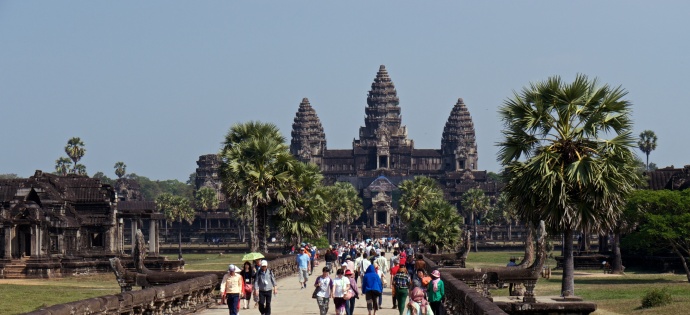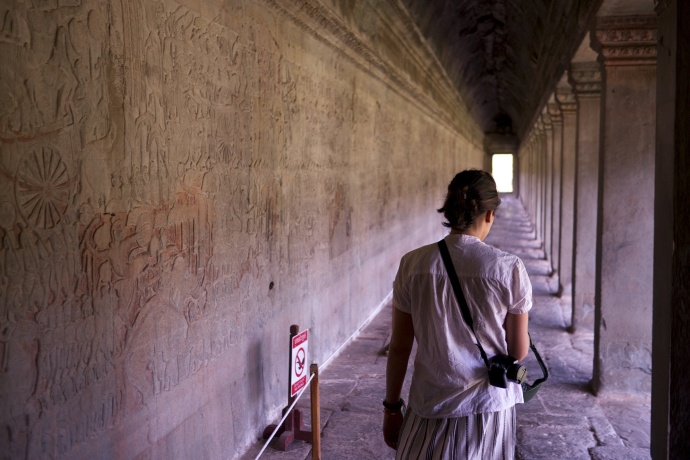Just before sunset, we walk up the giant crumbly steps of Bayon, one of the remaining central temples of Angkor Wat. Enormous faces, with upturned mouths and peaceful eyes, loom above us, then around us. Carved into dark stone, these reliefs are mossy now, wild in both their proportions and their green edges. Within the temple’s recesses lie bats, we can hear their chirping, and in the dusky light, I wonder what other creatures, creepy-crawlies, lie in the shadows and crevices. The air is humid, still, and we have the temple nearly to ourselves. The place feels eery, inhabited, like history might jump straight out from the walls. I expect a tap on my shoulder, ancient ancestors poking their gnarled fingers at me. We have watched Indiana Jones Temple of Doom the night before, and the unfortunate consequence is that I feel that strange feeling of familiarity, of a surreal moment produced by the simulacra of Hollywood. We clamber around, snapping pictures, gazing up at the monumental artisanship of those who inhabited this place a millennium ago. Would they have known the legacy they were creating? Could they in their wildest dreams have imagined us, camera-clad travellers from the New World, coming to admire their work? The sky is darkening and we leave such musings behind, whisked away in our air-conditioned van to our nearby hotel to celebrate, of all things, Christmas. Our hotel plays Christmas music, the lobby is decorated with gingerbread houses and a festive tree, and the temples feel far away.
The next morning, we rent rickety old bicycles and cycle the four kilometers to Angkor Wat itself. A giant moat surrounds this temple, the largest and most impressive of the dynasty. We park our bikes amidst the chaos that is the entrance, and walk past long serpents of stone that line the wide walkway. Walking through the first set of gates, Angkor Wat appears in full, its heft and enormity palpable. From a distance, it conveys grandeur, and a sense of fortitude—the remnants of a once great and mighty empire. Up close, its intricacy reveals itself and our eyes soak up the details—bas-relief painstakingly carved to reveal elaborate scenes from Hindu mythology. Depicted are Vishnu, beautiful Lakshmi, the four-armed Shiva, Hanuman the monkey god, amidst warriors, devils, horses, and elephants. The churning sea of milk holds fantastical sea life, and a fight between good and evil. All of these stories are chiseled into sandstone, large blocks of which are now weathered, graying, yet surprisingly intact. The crowds clear out around lunchtime and again we experience of the magic of having space to explore, to move around unencumbered by jostling tourist groups.
Later in the afternoon, we bike to a set of farther out temples, easily located by looking for the lined-up tour buses. The temples themselves are crowded, making them harder to appreciate, but they are awe-inspiring nonetheless. Even more enjoyable is the biking around and between the temples. We bike along shaded tree-lined streets that are unexpectedly quiet, and soak in the natural landscape within which these man-made wonders are situated. The first part of our bike ride feels pastoral—there are rice paddies and wandering skinny cows—but as we move farther out, forest takes over. We cross a bridge and gaze out over a marshy swamp, dotted in the distance with willowy trees. We reach another temple, this one quieter, almost hidden by the lush surrounding foliage. We look but do not stop, cycling onwards through gates carved with giant faces like those of Bayon. We are alone now, watched only by the row of statues that line the next bridge, and it is pure magic, the stuff of fantasy, only it is real, the time-worn vestiges of a vibrant civilization. That evening, amidst the gaudy lights and cheap bars of Siem Reap, I am relieved that the hordes of party-going tourists did not manage to discover our biking route. Over bites of delicious eggplant curry, noodle salad and coconut-cashew dip at local vegetarian restaurant (Chamkar, meaning farm in Cambodian), we take stock of the day. The Buddhist temples of Bagan lie behind us, the Taj Mahal ahead, and occupying the space in the middle of our journey, Ankgor Wat sits, timelessly, its network of temples mysteriously spread through overgrown jungle and marsh, its ethereal shapes and sizes making us wonder if we were ever really there.


